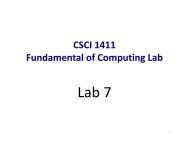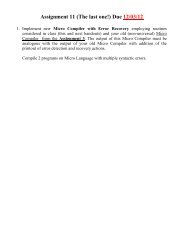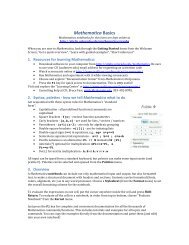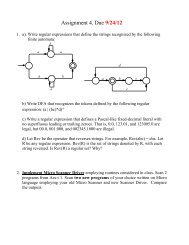[PDF] The Thickness and Chromatic Number of r - Gammeter.com
[PDF] The Thickness and Chromatic Number of r - Gammeter.com
[PDF] The Thickness and Chromatic Number of r - Gammeter.com
Create successful ePaper yourself
Turn your PDF publications into a flip-book with our unique Google optimized e-Paper software.
<strong>of</strong> r-inflated graphs, which in turn gives a bound on their thickness. For this work,<br />
we require more than the existence <strong>of</strong> a Hamiltonian path de<strong>com</strong>position for K2r. We<br />
also need a certain measure <strong>of</strong> control over the endpoints <strong>of</strong> the Hamiltonian paths,<br />
as well as control over the pairs <strong>of</strong> vertices that are incident to the center-most edges<br />
<strong>of</strong> the paths. <strong>The</strong> purpose <strong>of</strong> the following lemma <strong>and</strong> corollary is to provide us with<br />
this control.<br />
Lemma 1. Let K2r be a <strong>com</strong>plete graph on 2r vertices with vertices labeled v1,. . . , v2r.<br />
<strong>The</strong> edges <strong>of</strong> K2r can be partitioned into r Hamiltonian paths, P1, P2, . . . , Pr, each<br />
with one endpoint in {v1, v2, . . . , vr} <strong>and</strong> the other in {vr+1, vr+2, . . . , v2r}. Moreover<br />
every vertex in K2r appears as an endpoint <strong>of</strong> a unique Pi.<br />
Note that throughout the up<strong>com</strong>ing pro<strong>of</strong>, <strong>and</strong> indeed this paper, we will use<br />
{1, 2, . . . , 2r} as a system <strong>of</strong> distinct representatives for arithmetic modulo 2r.<br />
Pro<strong>of</strong>. Let P1 be the Hamiltonian path <strong>of</strong> K2r obtained by alternating vertices <strong>of</strong> the<br />
two sequences v1, v2, . . . , vr <strong>and</strong> v2r, v2r−1, . . . , vr+1, beginning with vertex v1. That<br />
is,<br />
P1 = v1, v2r, v2, v2r−1, . . . , vi, v2r−(i−1), vi+1, . . . , vr, vr+1.<br />
Notice that the sequence <strong>of</strong> differences mod 2r between the indices <strong>of</strong> consecutive<br />
vertices from left to right in P1 is given by {2i − 1, 2r − 2i : i = 1, . . . , r}, which as<br />
a set is the same as {1, 2, . . . , 2r − 1, 2r}.<br />
We generate a second path, P2, by increasing the index <strong>of</strong> each vertex in P1 by 1<br />
(mod 2r). That is,<br />
P2 = v2, v1, v3, v2r, . . . , vi+1, v2r−i+1, vi+2, . . . , vr+1, vr+2.<br />
We wish to show that these paths are edge disjoint. Note that Pi <strong>and</strong> Pj share<br />
an edge if <strong>and</strong> only if P1 <strong>and</strong> Pj−i+1 share an edge. By construction, the sequence <strong>of</strong><br />
consecutive differences <strong>of</strong> vertex indices is invariant (mod 2r). Thus the edges from<br />
vertex vi to its righth<strong>and</strong> neighbors in the paths P1, . . . , Pr are distinct. Similarly<br />
for its lefth<strong>and</strong> neighbors. <strong>The</strong> following will show that a righth<strong>and</strong> neighbor <strong>of</strong> vi<br />
in P1 cannot be a lefth<strong>and</strong> neighbor in some Pk.<br />
<strong>The</strong>re are two types <strong>of</strong> edges in P1. One has the form viv2r−i+1 <strong>and</strong> the other has<br />
the form vjv2r−j+2. We examine edges <strong>of</strong> the form viv2r−i+1; a similar <strong>com</strong>putation<br />
works for the other form. Suppose that v2r−i+1 is a righth<strong>and</strong> neighbor or vi in P1<br />
<strong>and</strong> a lefth<strong>and</strong> neighbor <strong>of</strong> vi in Pk. Since the edge v2r−i+1vi in Pk is obtained by<br />
adding k −1 to the indices <strong>of</strong> an edge in P1, it must have the form v2r−j+k+1vj+k−1 or<br />
vj+k−1v2r−j+k in Pk. In the first case, this implies that 2r − i + 1 = 2r − j + k + 1 <strong>and</strong><br />
7


![[PDF] The Thickness and Chromatic Number of r - Gammeter.com](https://img.yumpu.com/3978766/7/500x640/pdf-the-thickness-and-chromatic-number-of-r-gammetercom.jpg)





